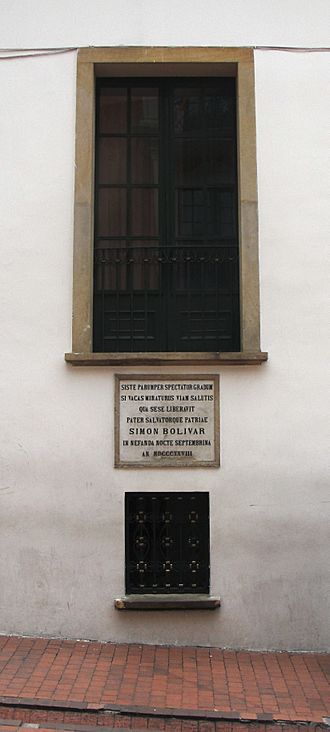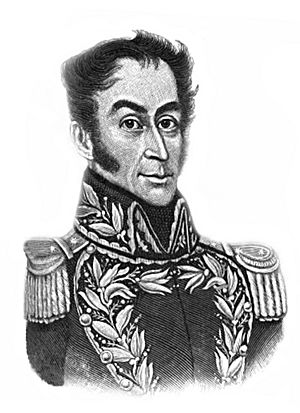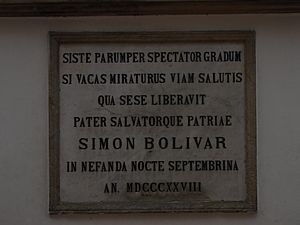Septembrine Conspiracy facts for kids

Window of the Palace of San Carlos through which Simón Bolívar escaped from the attack.
|
|
| Date | 25 September 1828 |
|---|---|
| Location | Palacio de San Carlos, Bogotá |
| Type | conspiracy and assassination attempt |
| Target | Simón Bolívar |
The Septembrine Conspiracy was a plan to kill Simón Bolívar. He was the president of a large country called Gran Colombia at the time. This event happened in Bogotá on September 25, 1828. About 36 attackers broke into the Presidential Palace late at night. They were led by Commander Pedro Carujo. After they killed the guards, they went to Bolívar's room. But Bolívar managed to escape through a window with help from his partner, Manuela Sáenz.
After the attack, trials were held. General Francisco de Paula Santander, who was Bolívar's main rival, was sentenced to death. However, Bolívar chose to spare his life and sent him away instead. These events played a part in Gran Colombia breaking apart just three years later.
Contents
Why Did People Oppose Bolívar?
Gran Colombia had a very strong central government. Military leaders often ignored the laws of the 1821 constitution. Many areas within Gran Colombia had wanted to govern themselves. They felt that the central government was not respecting their wishes. This led to many protests and revolts. People were upset about the military using its power unfairly. They wanted more control over their own regions and for their rights to be respected.
In 1826, Bolívar had to leave Peru. He went to deal with a rebellion in Gran Colombia called La Cosiata. Bolívar had tried to make a new constitution for Peru and Bolivia. This constitution would have made him ruler for life. But in January 1827, people in Peru rebelled. They said the new constitution was forced on them. Peru then removed Bolívar as a possible ruler.
A plan for a lifelong presidency was also discussed at the Convention of Ocaña. But it was rejected. No agreement was reached by June 10, 1828. On August 27, 1828, Simón Bolívar made a big decision. He signed a paper that closed Congress. He then set up a military government and called himself a dictator. This made many people even more unhappy with his rule.
The Night of the Attack
Opposition to Bolívar grew among liberal thinkers in Gran Colombia. This was especially true after he called himself a dictator. These liberals formed secret groups. They were called "SSP," which stood for "Parliamentary Socratic Society." These groups were like those during the French Revolution. They were mostly made up of students and smart people. They met to talk about political ideas. At one meeting, Luis Vargas Tejada gave a famous speech.
In early September of that year, the idea to kill Bolívar came from one of these meetings. To do this, they tried to get support from the army. They recruited former soldiers, reserves, and sergeants. They also brought in people who had been kicked out of the army for bad behavior.
Bolívar's Escape

On the night of September 25, about 12 civilians and 25 soldiers attacked. They were led by Pedro Carujo. They broke into the Presidential Palace (Palacio de San Carlos). They killed the guards. Then they went looking for Bolívar's room. Manuela Sáenz was with Bolívar that night. She woke him up. When Bolívar learned of the attack, he grabbed his pistol and sword. He tried to open the door. But Manuela convinced him to escape through the window instead.
Bolívar jumped out of the window. Manuela kept the attackers busy. Bolívar stayed hidden under a bridge all night. During the attack, Colonel William Ferguson, an English helper, was killed. A young man named Andrés Ibarra was hurt. And Bolívar's rescuer got a bump on his head. A freed slave named José Palacios took Bolívar to a safe place. A group of soldiers led by Colonel Whittle also helped stop the plot. Finally, Generals Rafael Urdaneta and José María Córdova ended the attack. They took control of the capital and arrested those involved.
What Happened After the Attack?
In the days that followed, many people were arrested. They were thought to be involved in the plot. This included high-ranking soldiers. Some were suspected of planning the attack. Others were thought to have helped or just kept quiet. Francisco de Paula Santander was accused, even without clear proof. Admiral José Prudencio Padilla was in prison when the attack happened. Some soldiers tried to free him. They wanted him to join their side. But Padilla refused. He said he was a prisoner and would not get involved.
Some people who were directly involved in the conspiracy were tried. These included Luis Vargas Tejada, Florentino González, Captain Emigdio Briceño Guzmán, and Pedro Carujo. They were found guilty. Their sentences were changed to exile, meaning they had to leave the country. Some, like Carujo, were later pardoned.
After a questionable trial, Santander was found guilty. He was removed from his position and sentenced to death. But Bolívar changed his sentence to exile. Azuero and González also had their sentences changed to exile. Vargas Tejada drowned in a river while trying to escape.
The events of the Septembrine Conspiracy and the trials that followed caused more anger against Bolívar. These events played a part in the dissolution of Gran Colombia.
See also
 In Spanish: Conspiración Septembrina para niños
In Spanish: Conspiración Septembrina para niños


